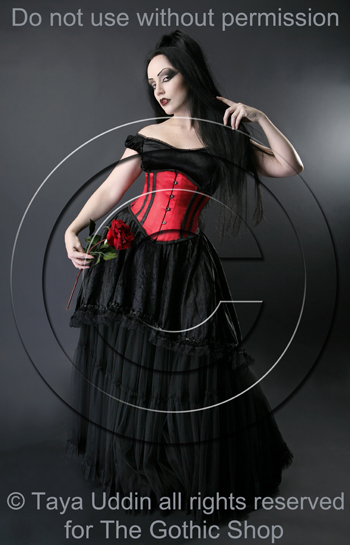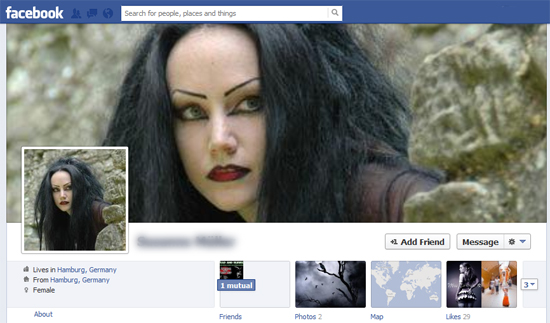Posted by Amaranth
What’s a picture worth?

In today’s world technology has given us a universe of information at our fingertips. The internet is a veritable encyclopaedia of everything and digital sharing devices have let us contribute our very own pages to that weighty tome. We can see, hear, experience and participate like never before. It is with this revolution we see talent grow as the means to make and share becomes more accessible. The large upsurge in alternative modelling and photography is a great example: digital cameras, powerful processing and online albums bring the creation and appreciation of this artform to anyone who cares to try. And I think this is wonderful.
But the question I ask, has this cheapened perceived value of output? Has it stopped it being a piece of art and simply a consumable that people feel justified in taking for their own use? The music industry has had a number of high profile cases in this regard, but on a more grass roots and rather more personal level I am quite tired of “the internet” believing they have the right to reproduce, publish, use and sometimes even transform images created by photographers, models and designers with no prior consent or citation. I know this is an issue which will affect many reading this article and is something I’ve been doing a fair bit of reading up on, so thought I’d share my findings.
What is “copyright”?
It is a right given to the creator of an artistic work to control the way in which their material may be used. The creator also has the right to be identified as the author and to object to any distortions of their work. Copyright relates only to the actual photograph rather than the idea behind the photograph. Copyright infringement relates to reproduction of all or part of the work and begins at creation and ends 70 years after the death of the creator.

The photographer owns the copyright
The person who takes the photograph owns the copyright and this copyright is implicit, meaning all images are still copyrighted even if it’s not explicitly stated or marked as such. The subject of the photograph does not obtain any copyright unless awarded by the photographer.
Written consent should be obtained for publication
While there is no real consent needed to take a photo of an individual (except in extenuating circumstances and these will be decided by the court), a model release should be obtained if the picture is to be published anywhere and the publisher should hold a copy. While it is not a law as such in the UK (however it is in the USA) the subject of the photograph could still sue under laws relating to privacy and defamation of character if they have been represented in a manner they disagree with.
Copyright violation still exists even if there is no financial gain
This is a common misconception and will only affect the amount of damages that can be claimed. If the person using your images is not doing so for financial gain, they are still breaking copyright laws. A cease and desist order can be issued in such cases and can end up in court if the order is ignored.
Publishing your work in the public domain does not waive the copyright
Unless the photographer specifically states that they place the images in the public domain for free use by means of a license, their work should only be viewed only in the location and manner in which it was published. This includes all work published on the internet.
Even if you purchase an image that does not give you the copyright
Ownership of a photograph only gives permission for personal use and enjoyment. In order to reproduce or use the work for anything other than personal use the copyright needs to be given, shared or sold along with the work or a license granted.
There are some exceptions where copyrighted material can be used called “fair dealing”
Fair dealing is a term used to describe some limited use that is allowed without infringing copyright:
- Research and private study: which is for non-commercial purposes and no copies are made available for a number of other people.
- Instruction or examination: provided the copying is done by a student or instructor and is for non-commercial purposes.
- Criticism or review: work can be used in this way if it can be found in the public domain and the material is accompanied by some actual discussion or assessment.
- News reporting: this does not apply to photographs.
- Incidental inclusion: this would be where the work is unintentionally included. An example could be if someone’s work were in the background of a video broadcast.
With all of the above the amount of work used should be no more than is necessary for the purpose and should always have the source acknowledged. A couple of images could illustrate an article for example but there is no need of a whole gallery.
It is not ok to use images of other people as a representation of yourself
Using someone else’s photograph or avatar on an online profile is not only against copyright laws but also amounts to impersonation. While impersonation is not illegal unless doing so for the purpose of financial gain or trying to get someone wrongfully suspected of a crime, it is morally distasteful and could amount to harassment or public nuisance suits being filed. It is also only a matter of time until this becomes more of a legal issue, with laws already being passed in USA covering this area. If you must use someone else’s image, please obtain permission from the copyright holder first and credit appropriately so there is no possibility that you can be mistaken for being that person.

Spare a thought
While all these legal implications are often unknown to those using other people’s work and should definitely be investigated, even without that knowledge; before you right-click and copy if you could just spare a thought. A thought for the time, effort and money the creators of that image put into it. For the people and/or companies it is representing. For the value of it. And then you’ll realise what you are about to do can be seen, at it’s very worst, as stealing and lying.
References:
http://www.copyrightservice.co.uk/copyright/p01_uk_copyright_law
http://www.sirimo.co.uk/2009/05/14/uk-photographers-rights-v2
http://www.photographywebsite.co.uk/copyright-in-photography-c494.html
http://onlinereputationedge.com/online-impersonation
http://www.photolaw.net/faq.html
http://www.copyrightservice.co.uk/copyright/p27_work_of_others#fair_dealing
Published in Alt Fashion
